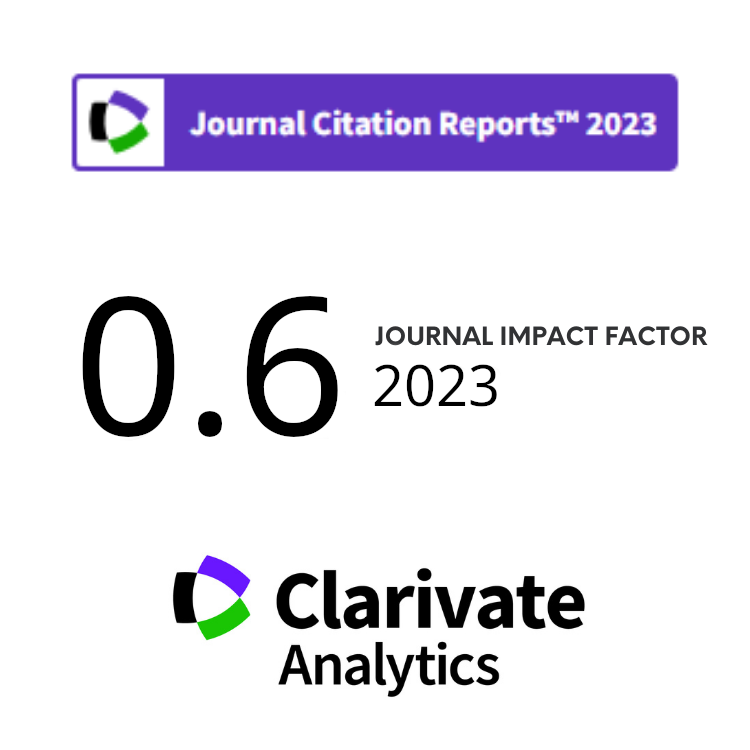Comparison of Lung Cancer Lesion Detection Capability on Standard Dose and Low Dose Computed Tomography Capabilities: An In-House Phantom Study
Abstract
Keywords
Full Text:
PDFReferences
WHO, Total #Cancer Cases (2018), 2020. https://www.who.int/publications/m/item/cancer-idn-2020. Retrieved in March 2024
C. McCollough, D. Cody, S. Edyvean et al., Report No. 96, The Measurement, Reporting, and Management of Radiation Dose in CT, American Association of Physicists in Medicine (AAPM), College Park (2008) 1.
R. Meza, J. Jeon, I. Toumazis et al., JAMA 325 (2021) 988.
L. Manuel, L.S. Fong, T. Ly et al., Interact. Cardiovasc. Thorac. Surg. 33 (2021) 741.
C. Goudemant, V. Durieux, B. Grigoriu et al., Rev. Mal. Respir. 38 (2021) 489.
M. Reck, S. Dettmer, H.-U. Kauczor et al., Dtsch. Arztebl. (2023) 387.
H. L. Lancaster, M. A. Heuvelmans, and M. Oudkerk, J. Intern. Med. 292 (2022) 68.
R. M. Hoffman, R. P. Atallah, R. D. Struble et al., J. Gen. Intern. Med. 35 (2020) 3015.
Council NR., Beir VII: Health Risks from Exposure to Low Levels of Ionizing Radiation. https://nap.nationalacademies.org/resource/11340/beir_vii_final.pdf. Retrieved in December 2024.
S. Iranmakani, A. R. Jahanshahi, P. Mehnati et al., J. Med. Signals. Sens. 12 (2022) 64.
G. L. Zeng, J. Radiol. Imaging 4 (2020) 45.
B. Jiang, N. Li, X. Shi et al., Radiol. 303 (2022) 202.
P.G. Mikhael, J. Wohlwend, A. Yala et al., J. Clin. Oncol. 41 (2023) 2191
J. A. Yeom, K. U. Kim, M. Hwang et al., Medicina (Lithuania) 58 (2022) 939.
L. E. Lubis, I. Hariyati, D. Ryangga et al., Atom Indones. 46 (2020) 69.
Y. Niu, S. Huang, H. Zhang et al., Quant. Imaging. Med. Surg. 11 (2021) 380.
J. Greffier, Y. Barbotteau, and F. Gardavaud, Diagn. Interv. Imaging 103 (2022) 555.
J. T. Bushberg, J.A. Siebert, E. M. Leidholdt et al., The Essential Physics of Medical Imaging, Wolters Kluwer Health / Lippincott Williams & Wilkins, Pennsylvania (2012).
J. B. Solomon, X. Li, E. Samei, Am. J. Roentgenol. 200 (2013) 592.
P. J. Mazzone, G. A. Silvestri, L. H. Souter et al., CHEST 160 (2021) e427.
K. Ichikawa, T. Kobayashi, M. Sagawa et al., J. Appl. Clin. Med. Phys. 16 (2015) 1.
M. E. Widiatmoko and S. Ramadanti, Jurnal Kesehatan Vokasional 8 (2023) 174. (in Indonesian)
K. M. Ogden, W. Huda, M. R. Khorasani et al. A Comparison of Three CT Voltage Optimization Strategies, in: Proceedings of SPIE 6913 (2008) 691351-1.
E. Seeram, Computed Tomography: Physical Principles, Clinical Applications, and Quality Control, Saunders, St. Louis (2016).
Priyanka, R. Kadavigere, and S. Sukumar, Clin. Neuroradiol. 34 (2024) 229.
M. Alshipli and N. A. Kabir, J. Phys.: Conf. Ser. 851 (2017) 012005.
J. M. Ford and S. J. Decker, J. Forensic. Radiol. Imaging 4 (2016) 43.
S. C. Bushong, Radiologic Science for Technologists: Physics, Biology, and Protection, Mosby; St. Louis, Missouri (2021).
O. Ekizoglu, E. Inci, E. Hocaoglu et al., J. Craniofac. Surg. 25 (2014) 957.
J. Wu, R. Li, H. Zhang et al., Thorac. Cancer 15 (2024) 1522.
H. D. R. Raharja, D. Putra, A. Naufal et al., Noise Power Spectrum (NPS) Characteristics on CT Imaging: Slice Thickness and Filter Types Variations, in: Proceedings of the 21st South-East Asian Congress of Medical Physics (SEACOMP) and 6th Annual Scientific Meeting on Medical Physics And Biophysics (PIT-FMB), AIP Publising (2024) 030014.
J. Choe, S. M. Lee, K. H. Do et al. Radiology 292 (2019)
H. Lang, J. Neubauer, B. Fritz et al., Eur. Radiol. 26 (2016) 4551.
M. Chillarón, V. Vidal, and G. Verdú, PLoS One 15 (2020) e0229113.
P. Monnin, A. Viry, F. R. Verdun et al., Phys. Med. Biol. 65 (2020) 105009.
M. Afadzi, E. K. Lysvik, H. K. Andersen et al., Eur. J. Radiol. 114 (2019) 62.
J. Gariani, S. P. Martin, D. Botsikas et al., Br. J. Radiol. 91 (2018) 20170443.
T. Kubo, Y. Ohno, M. Nishino et al., Eur. J. Radiol. Open 3 (2016) 86.
A. Ruano-Ravina, M. Pérez-Ríos, P. Casàn-Clará et al., Lancet Oncol. 19 (2018) e131.
H. Shen, Front. Med. 12 (2018) 116.
S. Park, J. H. Yoon, I. Joo et al., Eur. Radiol. 32 (2022) 2865.
DOI: https://doi.org/10.55981/aij.2025.1587
Copyright (c) 2025 Atom Indonesia

This work is licensed under a Creative Commons Attribution-NonCommercial-ShareAlike 4.0 International License.












